The use of Cannabis sativa L. for pest control: from the ethnobotanical knowledge to a systematic review of experimental studies
Authors:
Genís Oña, Manica Balant, José Carlos Bouso, Airy Gras, Joan Vallès, Daniel Vitales, and Teresa Garnatje.
Journal:
Cannabis and Cannabinoid Research
Year:
2021
About the study
This study was a collaboration with the Institut Botànic de Barcelona, an institution that is part of the Consejo Superior de Investigaciones Científicas (Spanish National Research Council), in the framework of Genís Oña’s PhD.
It is the first study in a new line of research focused on how psychoactive plants can have an impact on the damage caused by climate change. Cannabis, as an eco-friendly product, could replace the use of chemical pesticides for pest control. Moreover, it is a very efficient crop, as it produces a lot of essential oil, and the whole plant is used. The essential oil would be the pesticide product from the aerial parts of the plant, while the other parts can be used to make fibres, fabrics, etc.
This research has brought together different types of knowledge, following the ICEERS line of bridging knowledge. An initial review of ethnobotanical uses of cannabis as a pesticide has been carried out, followed by experimental studies on the subject. In this way, it is still traditional knowledge that is once again guiding the development of solutions to global problems.
Abstract
Background: Despite the benefits that synthetic pesticides have provided in terms of pest and disease control, they cause serious long-term consequences for both the environment and living organisms. Interest in eco-friendly products has subsequently increased in recent years.
Methods: This article briefly analyzes the available ethnobotanical evidence regarding the use of Cannabis sativa as a pesticide and offers a systematic review of experimental studies.
Results: Our findings indicate that both ethnobotanical and experimental procedures support the use of C. sativa as a pesticide, as remarkable toxicity has been observed against pest organisms. The results included in the systematic review of experimental studies (n=30) show a high degree of heterogeneity, but certain conclusions can be extracted to guide further research. For instance, promising pesticide properties were reported for most of the groups of species tested, especially Arachnida and Insecta; the efficacy of C. sativa as a pesticide can be derived from a wide variety of compounds that it contains and possible synergistic effects; it is crucial to standardize the phytochemical profile of C. sativa plants used as well as to obtain easily reproducible results; appropriate extraction methods should be explored; and upper inflorescences of the plant may be preferred for the production of the essential oil, but further studies should explore better other parts of the plant.
Conclusion: In the coming years, as new findings are produced, the promising potential of C. sativa as a pesticide will be elucidated, and reviews such as the present one constitute useful basic tools to make these processes easier.
Photo by Arjun MJ on Unsplash.
Categories:
Studies & papers
, Cannabis
Tags:
cannabis
, scientific research
, study
, ethnobotanicals
, traditional medicine
, biopesticides
, pest control
, hemp

